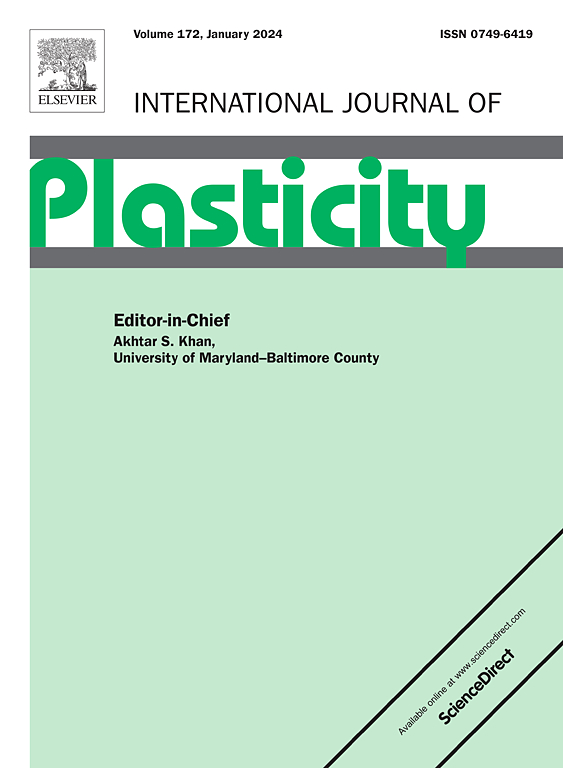CoCrFeNi微纤维的尺寸依赖性力学行为和机制
IF 9.4
1区 材料科学
Q1 ENGINEERING, MECHANICAL
引用次数: 0
摘要
高熵合金(HEAs)表现出多种多样的晶体缺陷以控制其性能。由于内因和外因尺寸效应,在超细纤维中制备HEAs进一步提高了性能的可控性。本研究通过拉伸、电流退火和电抛光得到直径30 ~ 100 μm、晶粒尺寸2.1 ~ 60.6 μm的CoCrFeNi高熵合金微纤维,并进行单轴拉伸试验。付款交单;(3)屈服强度与d符合Hall-Petch关系,对d的影响越小越弱或对d不敏感。(3)屈服强度与d呈正偏离Hall-Petch关系,对d的影响越小越强。3行为是由于晶界强化和表面晶粒软化,而D/ D <;这一行为主要受位错积累减少和晶粒数量有限影响的尺寸效应驱动。这些发现表明,在小直径微纤维中,强化和弱化机制相互交织,产生复杂的尺寸效应,从而提供了通过粒度控制和外部尺寸调节来定制微尺寸多晶组分力学性能的潜力。本文章由计算机程序翻译,如有差异,请以英文原文为准。


Size-dependent mechanical behaviors and mechanisms in CoCrFeNi microfibers
High-entropy alloys (HEAs) exhibit a wide diversity of crystalline defects for property control. Fabricating HEAs in microfiber forms further enhances property controllability due to intrinsic and extrinsic size effects. In this study, CoCrFeNi high entropy alloy microfibers with 30–100 μm diameters (D) and grain sizes (d) of 2.1–60.6 μm, were obtained through drawing, electric current annealing, and electropolishing, and subjected to uniaxial tensile testing. As D/d > 3, the yield strength obeys the Hall-Petch relation concerning d and a smaller-is-weaker effect or is insensitive to D. When D/d < 3, the yield strength deviates positively from the Hall-Petch relationship with respect to d and a smaller-is-stronger effect to D. The D/d > 3 behavior is due to grain boundary strengthening and surface-grain softening, while the D/d < 3 behavior is driven by reduced dislocation accumulation and size effects influenced by the limited number of grains spanning the diameter. These findings illustrate that in small-diameter microfibers, strengthening and weakening mechanisms intertwine to yield complex size effects, thus offering the potential to tailor the mechanical properties of micro-sized polycrystalline components through grain-size control and external-size adjustment.
求助全文
通过发布文献求助,成功后即可免费获取论文全文。
去求助
来源期刊

International Journal of Plasticity
工程技术-材料科学:综合
CiteScore
15.30
自引率
26.50%
发文量
256
审稿时长
46 days
期刊介绍:
International Journal of Plasticity aims to present original research encompassing all facets of plastic deformation, damage, and fracture behavior in both isotropic and anisotropic solids. This includes exploring the thermodynamics of plasticity and fracture, continuum theory, and macroscopic as well as microscopic phenomena.
Topics of interest span the plastic behavior of single crystals and polycrystalline metals, ceramics, rocks, soils, composites, nanocrystalline and microelectronics materials, shape memory alloys, ferroelectric ceramics, thin films, and polymers. Additionally, the journal covers plasticity aspects of failure and fracture mechanics. Contributions involving significant experimental, numerical, or theoretical advancements that enhance the understanding of the plastic behavior of solids are particularly valued. Papers addressing the modeling of finite nonlinear elastic deformation, bearing similarities to the modeling of plastic deformation, are also welcomed.
 求助内容:
求助内容: 应助结果提醒方式:
应助结果提醒方式:


